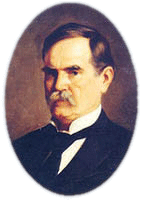|
|
Thomas Mitchell Campbell (1856-1923), governor of Texas, was born at Rusk, Texas, on April 22, 1856, the son of Thomas Duncan and Rachel (Moore) Campbell. He attended common schools at Rusk before entering Trinity University (then located at Tehuacana) to study law in 1873. Lack of finances forced him to withdraw after a year, but he got a job in the Gregg county clerk's office and studied law at night. In 1878 he was admitted to the Texas bar and began his practice in Longview. In the same year, he married Fannie Irene Bruner of Shreveport, Louisiana; they had five children. Campbell practiced law in Longview until he was appointed a master in chancery for the troubled International-Great Northern Railroad in 1889. Financier Jay Gould had allowed the ailing railroad to default on its debts in 1888 and then forced it into federal receivership in order to gain eventual control of it. Campbell soon found himself deeply involved in guiding the railroad's recovery. He became its court-appointed receiver in 1891 and moved his family to Palestine. The next year, after lifting the line from bankruptcy, he remained in Palestine as the general manager of the railroad. However, Gould managed to gain control anyway, and Campbell found his own attitudes clashing with the business practices of his employer. Campbell distrusted monopolistic big business and sympathized with organized labor. He shared many of the reformist political views of his lifelong friend, former governor James Stephen Hogg. In 1897 Campbell resigned from the railroad, returned to private law practice in Palestine, and became active in Democratic party politics. He attended several Democratic conventions and subsequently, at Hogg's urging, decided to run for governor. Though Hogg died before the campaign got underway, Campbell used his endorsement and promised to resurrect his friend's antitrust policies. His campaign gained added impetus when Senator Joseph Weldon Bailey threw his support to the Palestine lawyer, and Campbell was elected governor in 1906. In his two terms in office, 1907-1911, Campbell initiated a number of reforms involving railroad regulation, antitrust laws, lobbying restrictions, equitable taxation, and pure food and drug laws. Under his administration the Robertson Insurance Law (1907) brought to a halt the insurance companies' practice of realizing large profits in Texas without investing policy reserves in the state. The most significant legislation centered on prison reform, as Campbell's administration ended the contract lease system for inmates and implemented more humane treatment of prisoners. Under Campbell many state agencies also came into being, including the Department of Insurance and Banking, the Bureau of Labor Statistics, the State Board of Health, and the Texas State Library. Upon leaving the governorship Campbell returned to private law practice in Palestine but remained active in Democratic politics. In 1916 he ran unsuccessfully for the United States Senate. In 1917 he served on the exemption board for World War I. He died in Galveston on April 1, 1923, and was buried in Palestine. BIBLIOGRAPHY: Thomas Mitchell Campbell Letters and Papers, Texas State Archives, Austin. Thomas Mitchell Campbell Papers, Barker Texas History Center, University of Texas at Austin. Ross Phares, The Governors of Texas (Gretna, Louisiana: Pelican, 1976). Janet Schmelzer, "Thomas M. Campbell, Progressive Governor of Texas," Red River Valley Historical Review 3 (Fall 1978). Janet Schmelzer Reprinted with permission from the Handbook of Texas Online, a joint project of the Texas State Historical Association and the General Libraries at the University of Texas at Austin. © 2003, The Texas State Historical Association.
|
